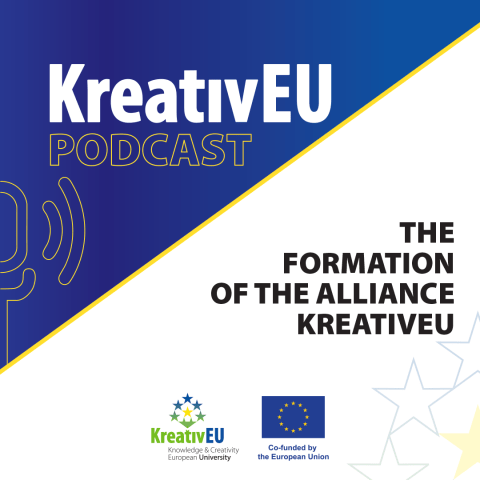Our first podcast on KreativEU
BUas chairman Jorrit Snijder and project lead Sannie van Boxtel recently recorded a podcast in which they emphasise the importance of BUas’ participation in the KreativEU alliance. The podcast is in Dutch but don’t worry – we’ve pulled out the highlights for you.
- KreativEU
- Collaboration
- Global engagement
- About BUas
When BUas sought European partnerships, we found the perfect match in KreativEU – an alliance of European universities of applied sciences united by shared ambitions. This wasn’t simply a board decision; it was, as Jorrit describes it, ‘a large-scale dating process’ to find the right fit.
What makes KreativEU special is the remarkable synergy between its themes and BUas’ research agenda and degree programmes. Creativity, cultural heritage, and sustainability are key, with AI seamlessly integrated across all domains.
KreativEU unites institutions that are equally committed to delivering top-notch education and recognise the vital role of research and innovation. Most importantly, these universities share a common DNA – a positive, forward-looking perspective and a genuine desire to make the world a better place.
In the podcast Jorrit comes up with a concrete example. Europe’s small and medium-sized enterprises (SMEs) often find innovation challenging. Caught up in the day-to-day pressures of meeting revenue targets, they simply lack the time and capacity to focus on it. This is where KreativEU comes in. With their strong SME networks, the universities involved are ideally placed to help bridge this innovation by bringing in fresh student talent – ultimately helping Europe hold its own on the global stage.
Sannie is project leader of the KreativEU team within BUas and sheds light on a number of specific KreativEU projects. Within the KreativEU framework, BUas leads Work Package 5, focusing on AI and sustainability. In this context, we organise international hackathons where students, researchers, and professionals collaborate to connect cultural heritage with sustainability through AI solutions. Recent events in Poland and the Czech Republic have produced innovation ideas like apps bringing historical stories to life and tools helping heritage managers with climate adaptation.
Our expertise in applied AI, championed by Professor Carlos Santos, is in high demand across the KreativEU alliance – partners frequently call on us for support. But it’s very much a two-way street. While we share our AI knowledge, we gain fresh insights into fields like cultural heritage and archaeology. This genuine cross-pollination speeds up development for everyone and gives our students valuable international experience.
Participation in this alliance is also important as it opens doors. Being an active KreativEU member recently secured BUas an invitation to the Sorbonne for Von der Leyen and Macron’s ‘Choose Europe for Science’ initiative – an opportunity that simply wouldn’t have been possible in the pre-KreativEU era.
Managing eleven partners across Europe requires what Jorrit calls ‘fortwursteln’ – a Habsburg-era term meaning ‘muddling through’. Different systems, cultures, and expectations need to be bridged, which takes time but ultimately strengthens the partnership. While this step-by-step approach might appear inefficient, those small steps add up. Looking back, they amount to giant leaps forward.
Looking ahead, Sannie sees short-term goals focused on getting as many students as possible involved in exchanges and European projects. In the medium term, plans include developing joint masters degrees, micro-credentials – which certify learning from short-term courses – and expanding research partnerships. The long-term vision? A dynamic, proactive campus – whether physical or virtual – where people keep learning from each other and remain open to different perspectives and ideas.
KreativEU is all about connection – linking people, disciplines, and regions. In a world that’s becoming more divided, it stands for Europe’s democratic values while fostering innovation and resilience. As Jorrit puts it: ‘The future lies in Europe, and as a university of applied sciences like ours, we need to play an active role in it.’
Listen to the original story here (in Dutch)
